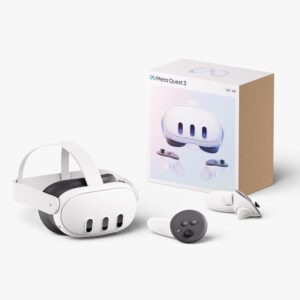
Quest 3 – 512 Gb
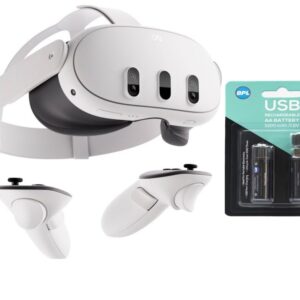
Meta Quest 3 – 128 Gb
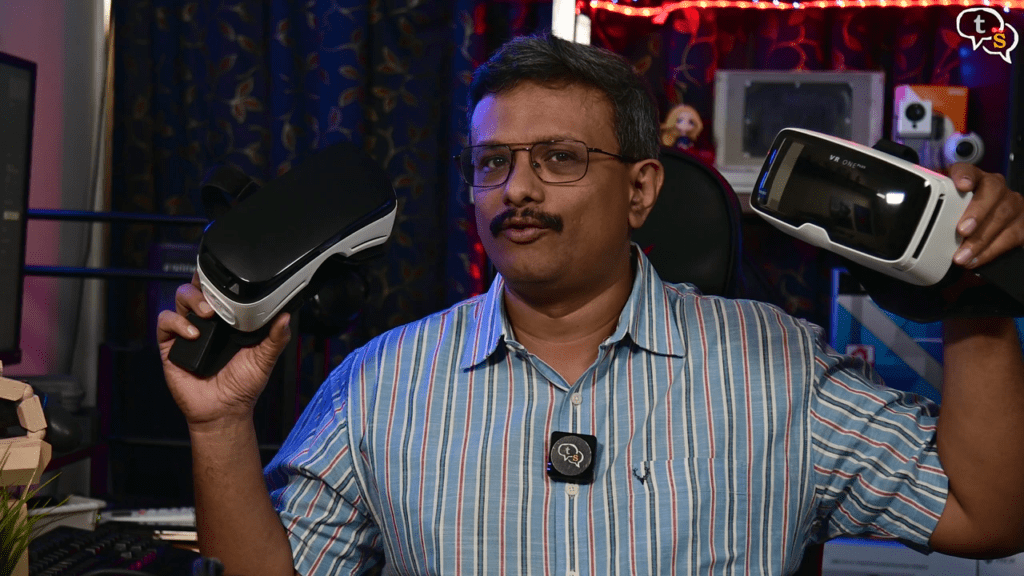
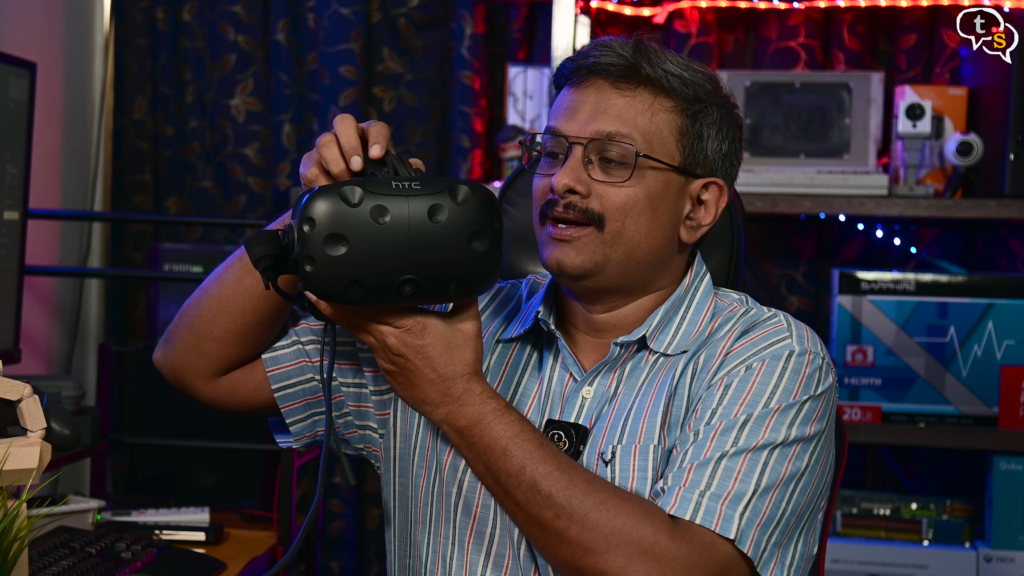
I’ve been using VR for years now, from the time of pseudo VR where I used these headsets that needed a mobile phone, to my first actual VR headset the HTC Vive.
The Vive was my first foray into actual VR with controllers, and inbuilt screen etc, but it was cumbersome to setup and you need a lot of space to play.
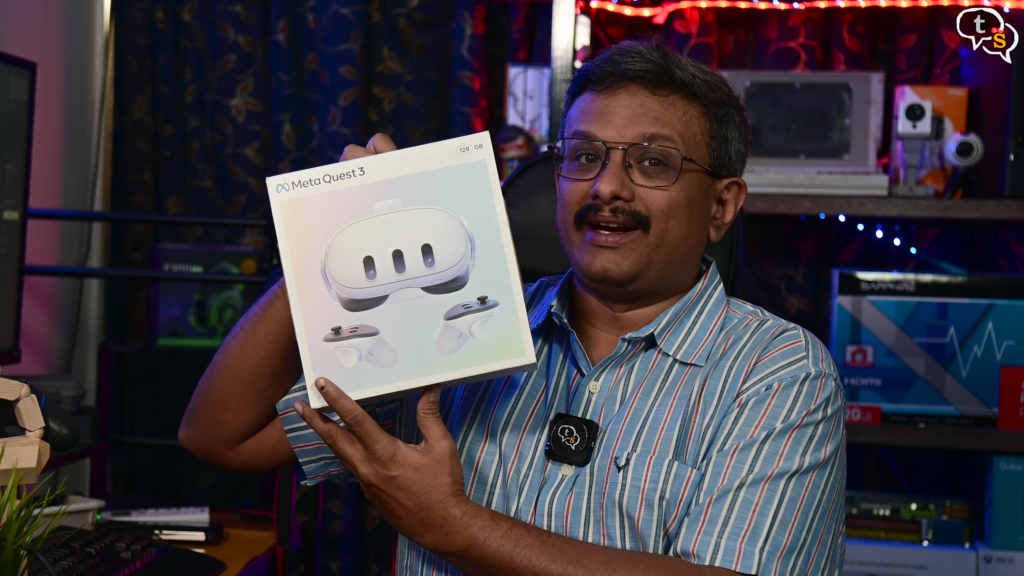
I wanted a wireless self-contained solution and I have here the Meta Quest 3, Meta’s newest VR Headset. How good is it?
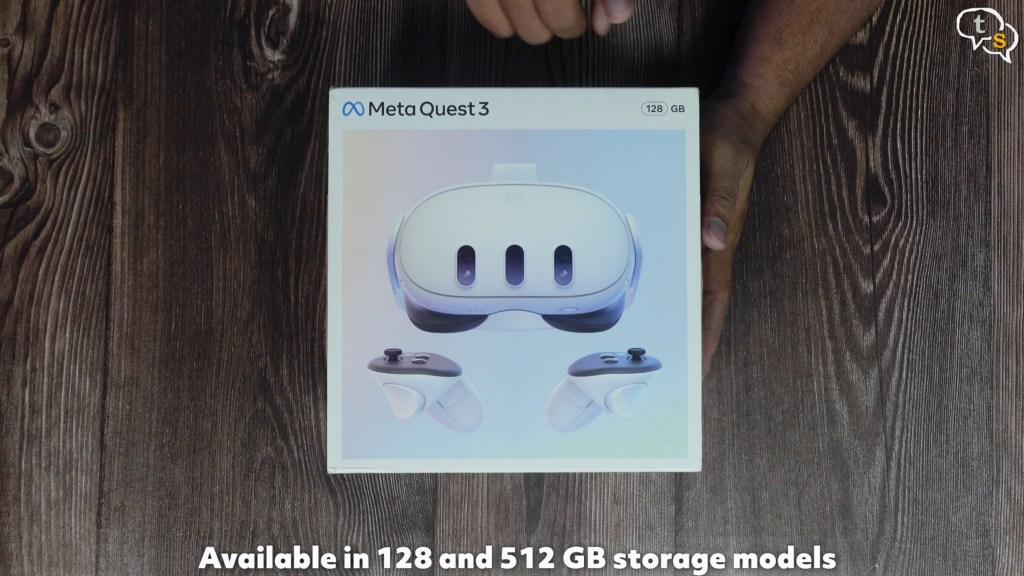
This is the Meta Quest 3 the successor to the already popular Meta Quest 2. This is the 128 GB storage version, there’s also a 512 GB version and nothing in between.

We have the headset and controllers on the box, we have the meta logo on the side. Since Facebook purchased Oculus and rebranded themselves as Meta their products have the meta name. This is an imported model, it’s not officially available in India yet. It looks to be a Japanese version. The internal box slides out like so.
Nice.

Meta Quest 3 marked within, quite simple.
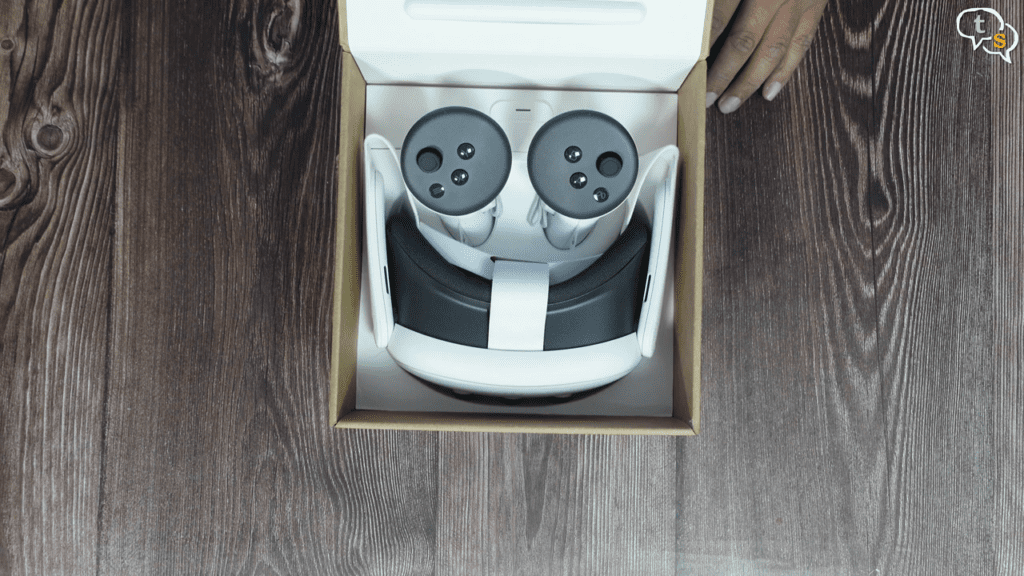
Tearing away the straps on the side, and opening it up, we have the headset and controllers within.
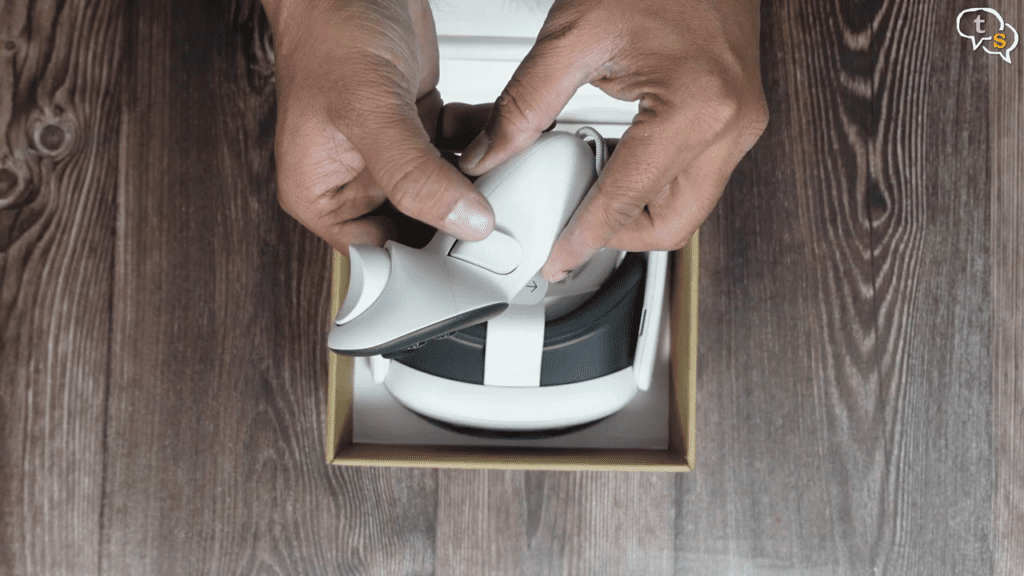
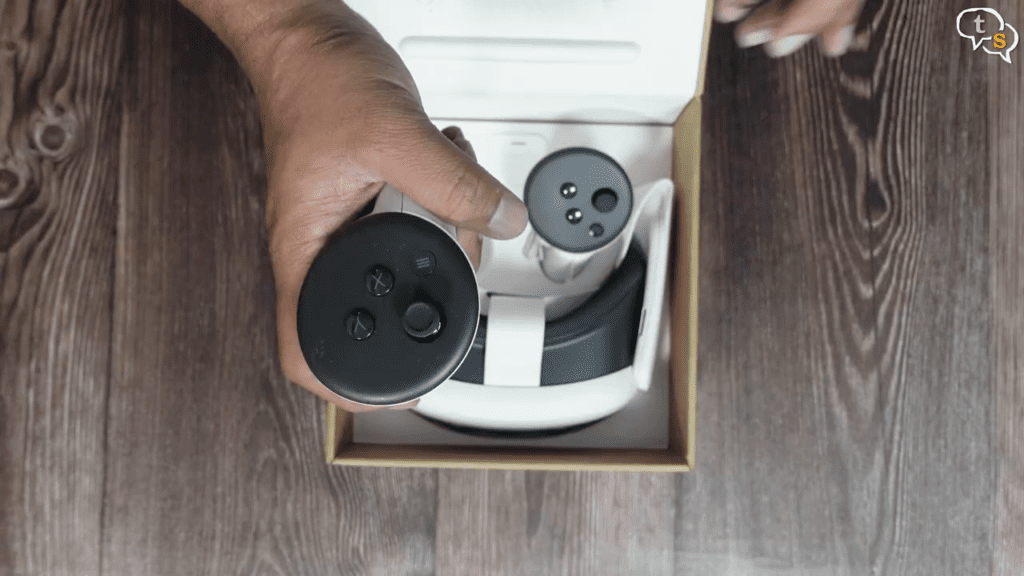
This is the headset and here’s one of the controllers. This is the left-hand controller, I like that the shape allows us to identify which one is which by just holding it. They weigh 126 grams each. With haptic feedback, it makes VR more immersive.
Here’s the trigger and it’s easy to access when holding the controller.
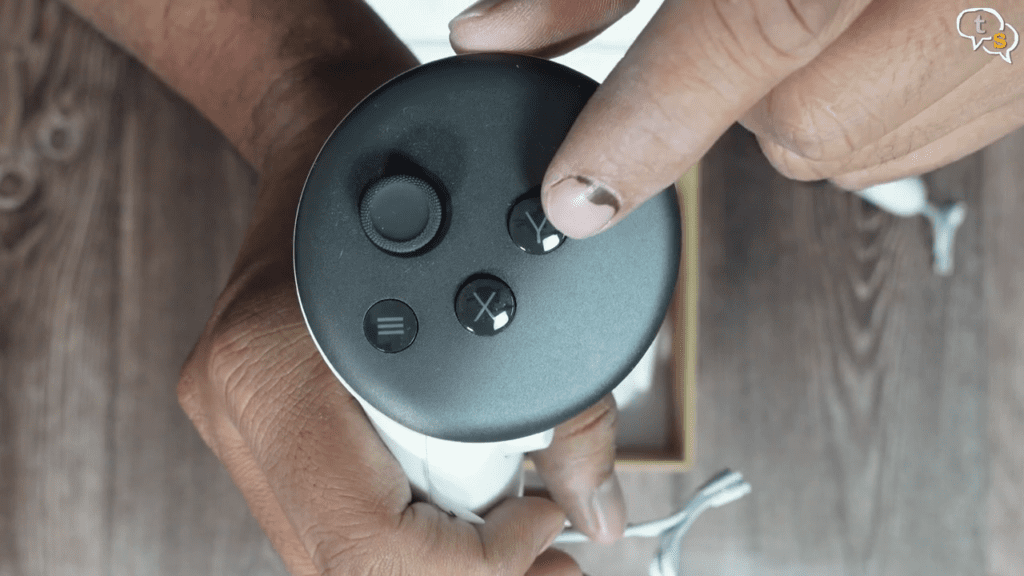
This is a grip button that you would press when holding the controller. Y, X buttons and a thumbstick are present on top. The Quest 2’s loops are now not present on the Quest 3 controllers. This button here is the options button for the in-game menu.
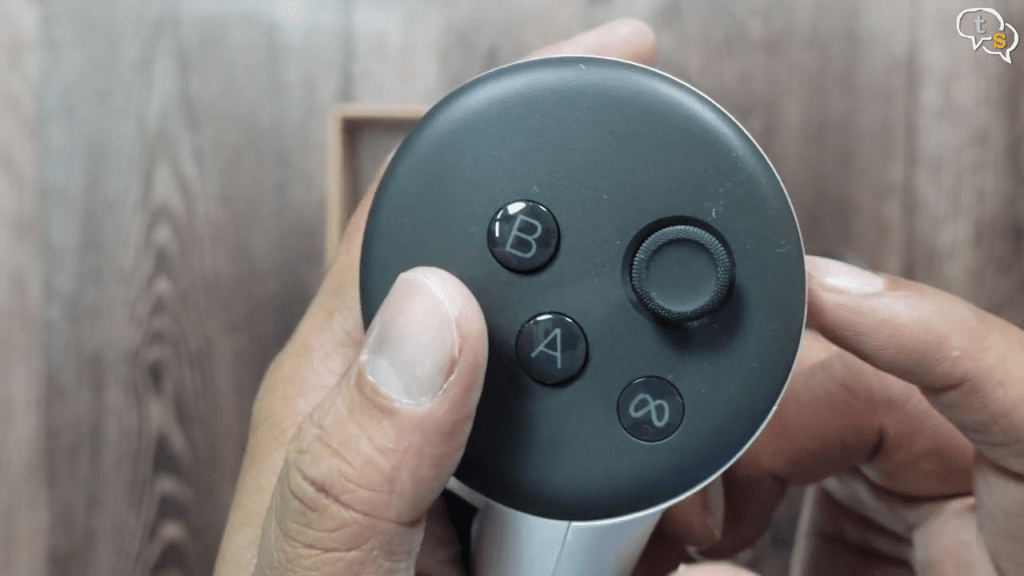
Here’s the other controller, A and B buttons, thumb-stick, and a meta button.
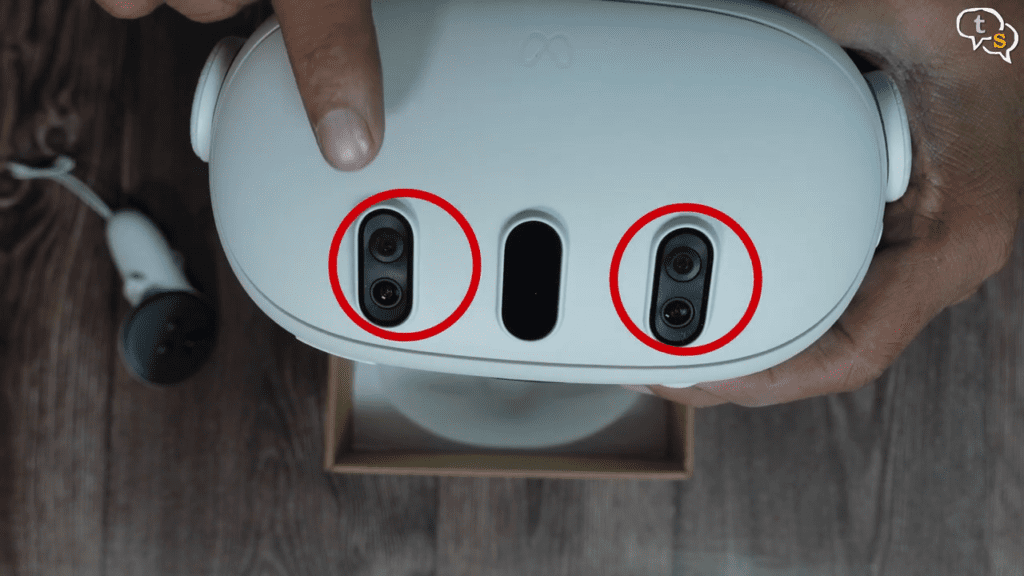
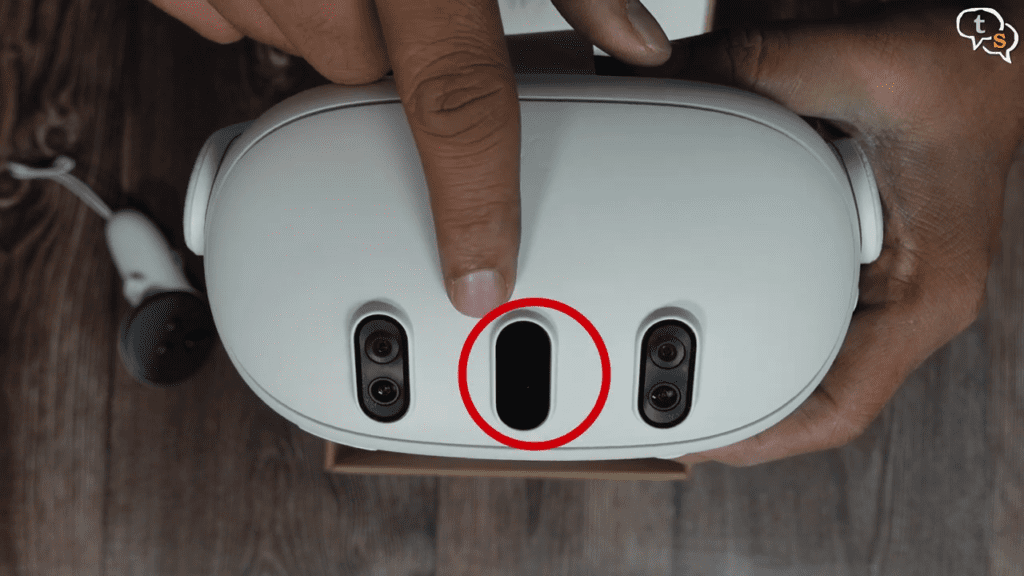
Now for the headset.
It uses a combination of cameras and a depth sensor to map the play area.
These are the cameras, and the depth or time of flight sensor can be found in the center. Other than the quest pro at this moment only the quest 3 has a depth sensor.
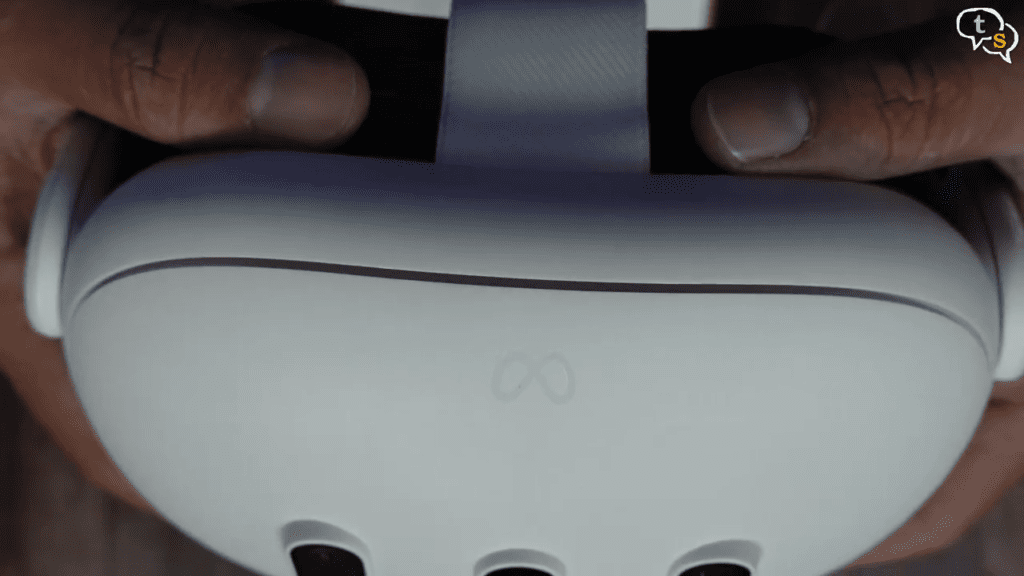
Meta logo can be found here.
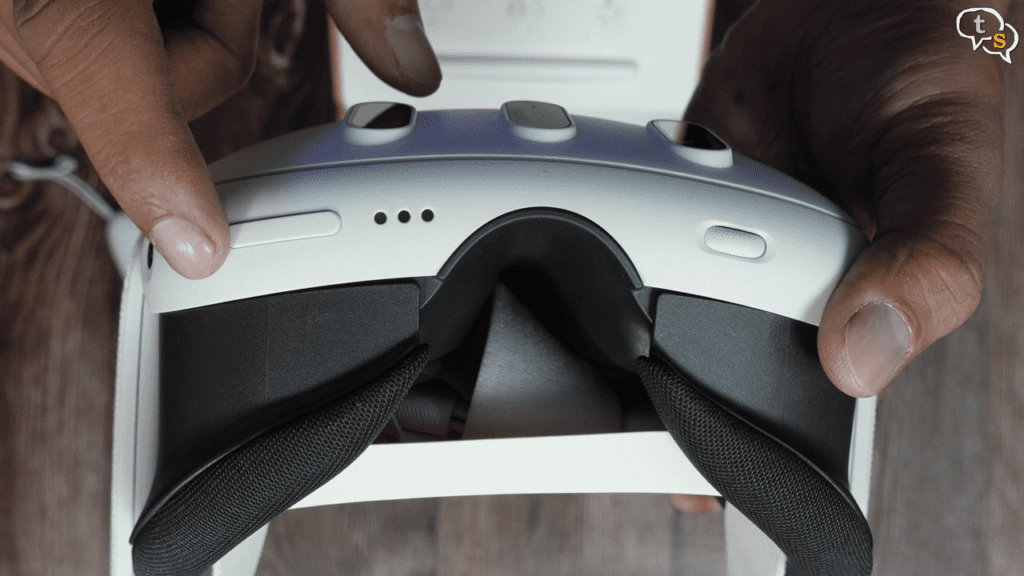
Volume buttons can be found under the headset, the metal prongs are for charging, if you purchase the dock.
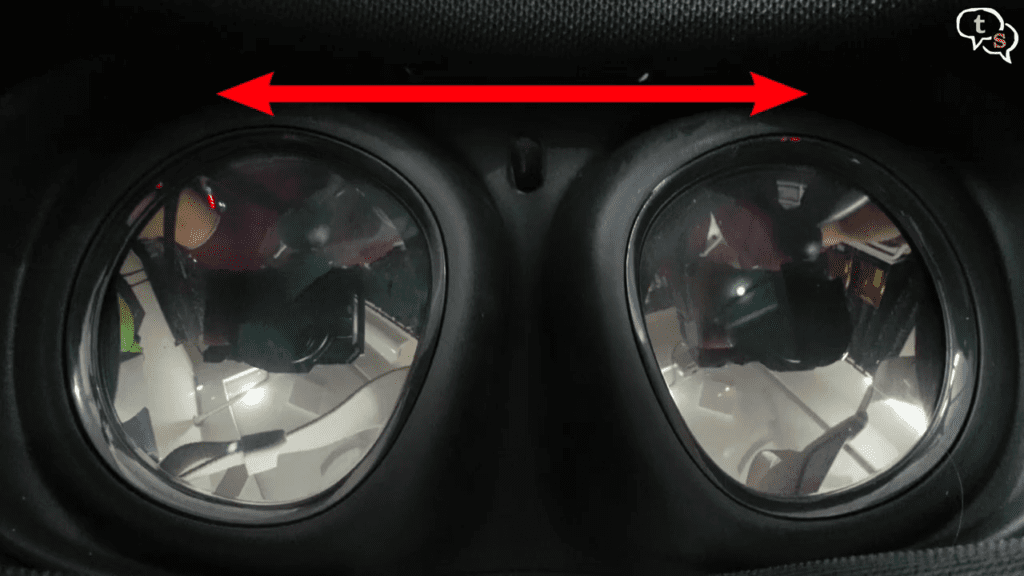
This dial here is to adjust the interpupillary distance, basically setting the distance between your pupils for better focus as the displays would be right before your eyes as opposed to the sides which can cause discomfort. This can be changed even when you have the headset on.
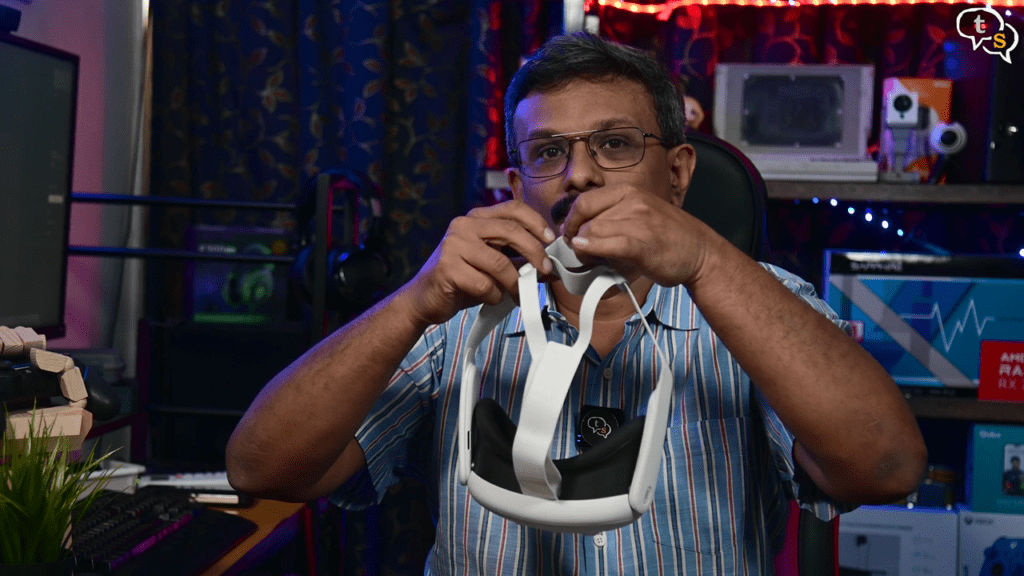
The strap is y shaped with a means to tighten the strap using these sections on the back.
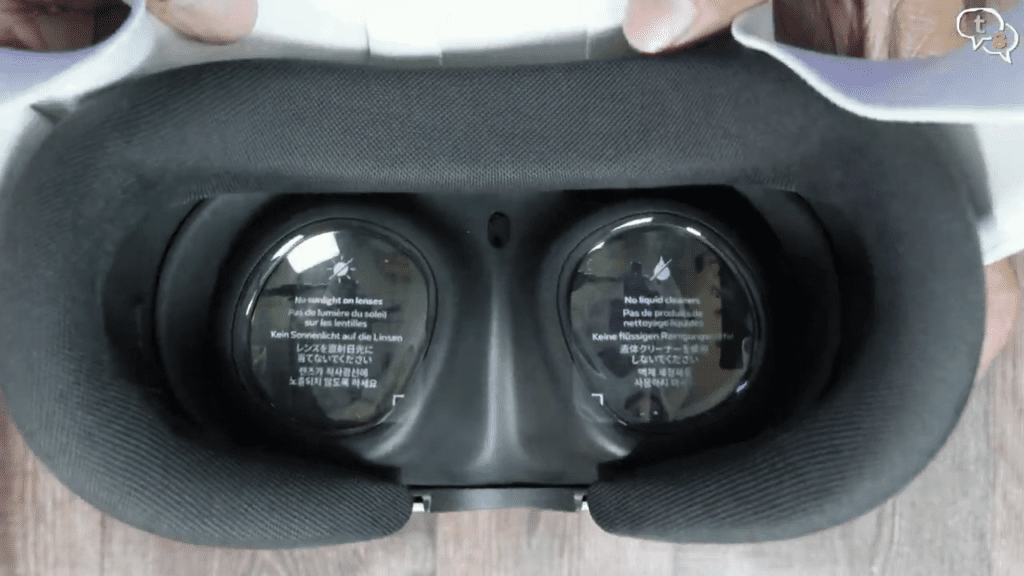
Here is the padded facial cushion.
Here are the lenses or the actual displays. These are LCD with a resolution of 2064×2208 pixels per eye. Meta calls it the 4k+ infinite display, yes it’s 4k if you add the two. But i don’t think it can provide 4k quality.
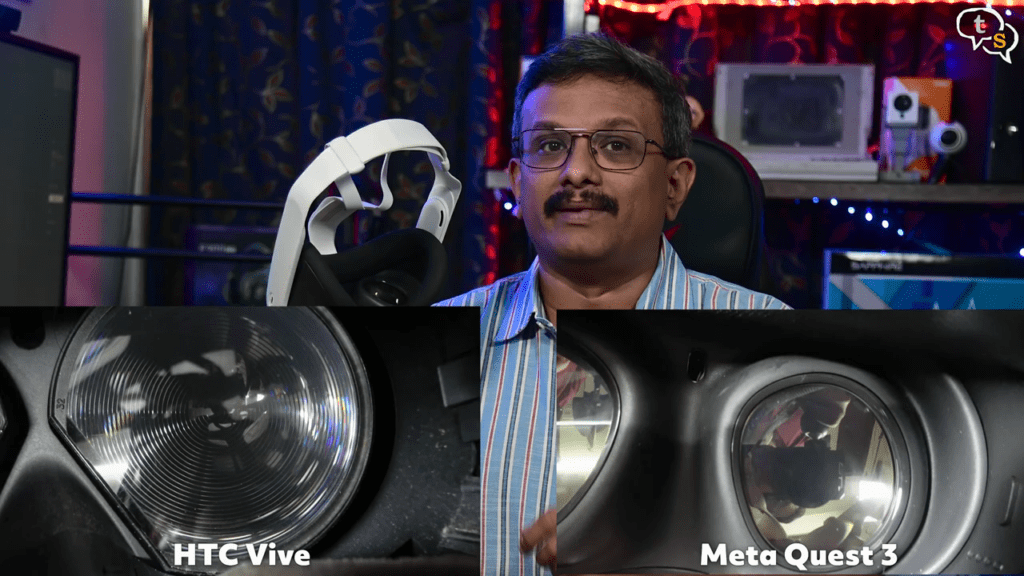
The lenses are called pancake lenses which is a big improvement as compared to the fresnel lenses from previous models. Even my HTC Vive has fresnel lenses. The pancake lenses allow for much thinner lenses and a better field of view. We don’t have these annoying circles on them. It’s much clearer, sharper and has a 110 degree horizontal and 96 degree vertical field of view. The ppd or pixels per degree is 25 ppd which is higher than the 20 ppd on the Quest 2 and even better than the Quest pro’s 22 ppd. The human eye is stated to have a retinal resolution of 60 ppd, so we are still much away, but getting there slowly. This sensor here detects if the headset is being worn and turns on the display only when this is triggered.
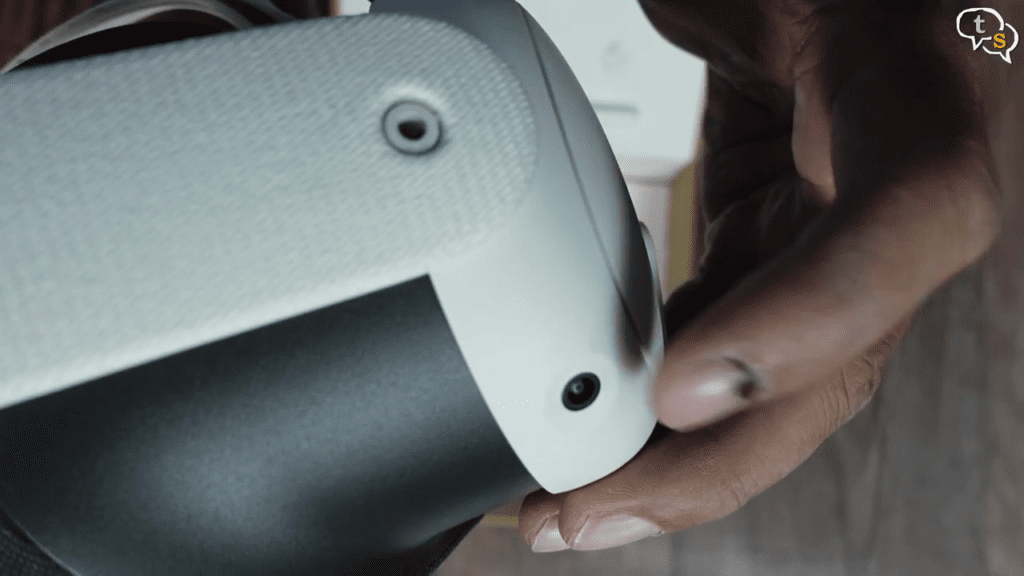
We have a 3.5 mm jack on the side, if you want to use external headphones,
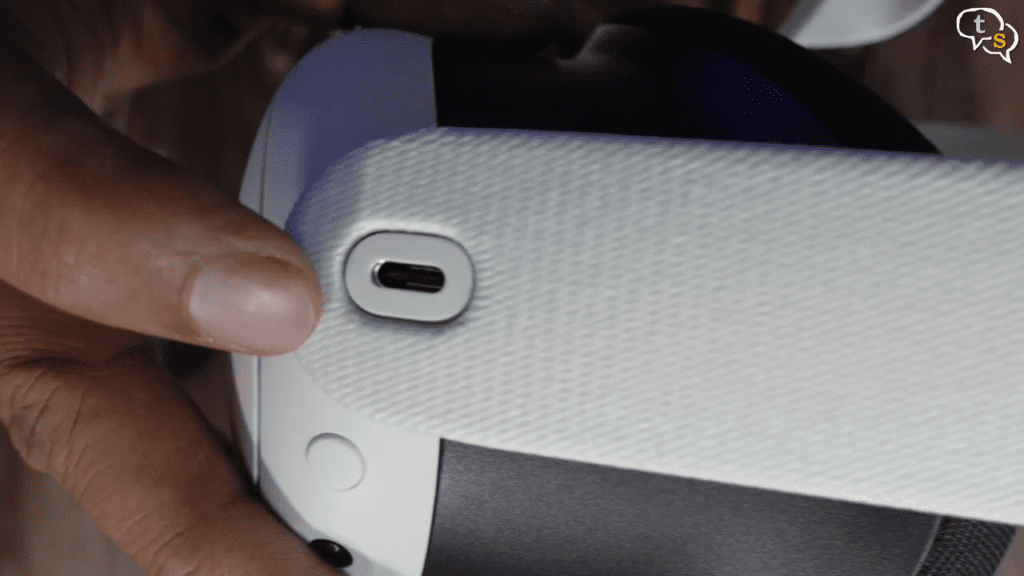

The other side has a USB-C port, which allows for charging and also can be used to link to a PC.
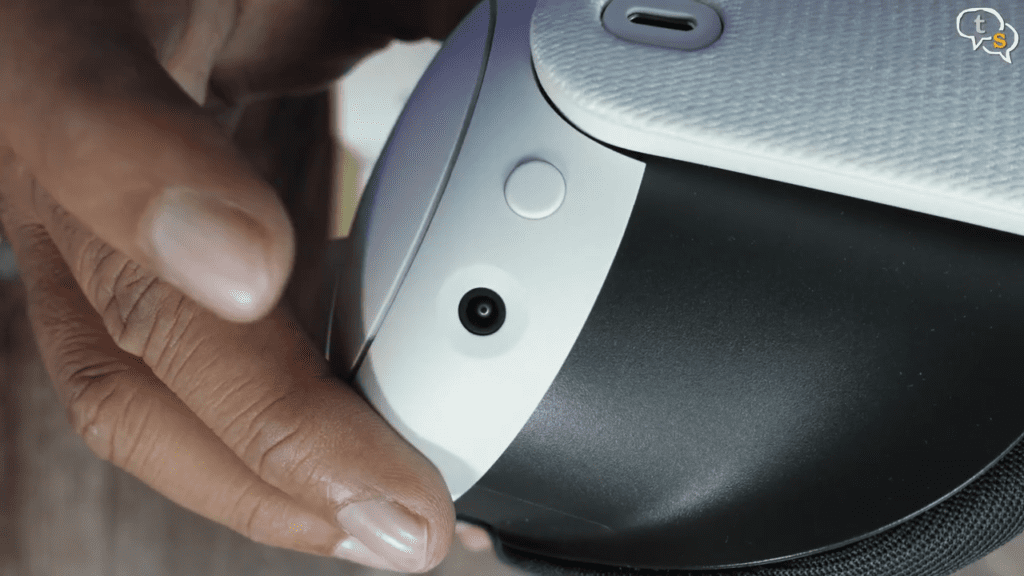




Below that is the power button, and under that is a tracking camera, another one can be found on the other side too.
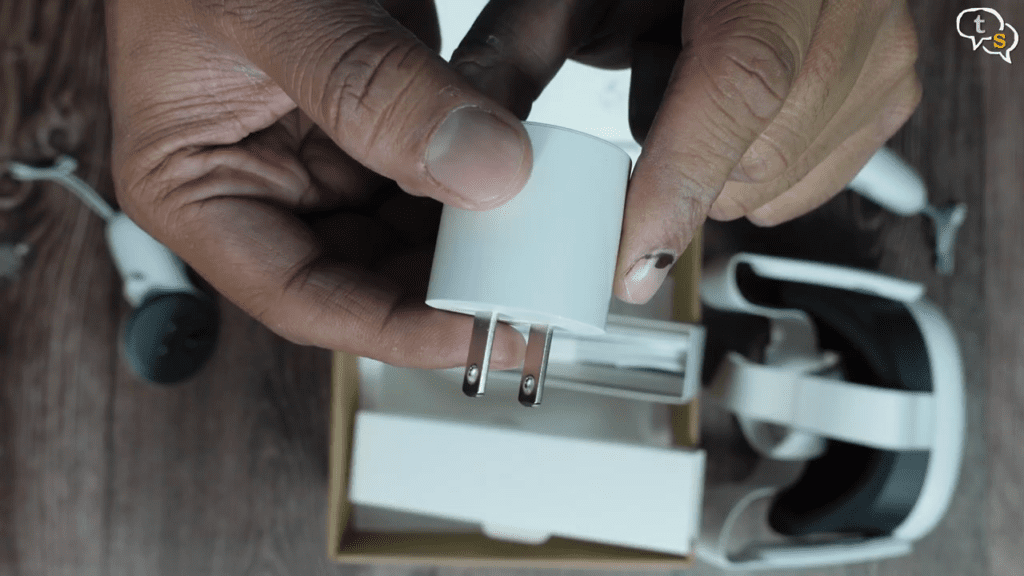

What else is in the box, a charging, cylinder and a usb-c cable.
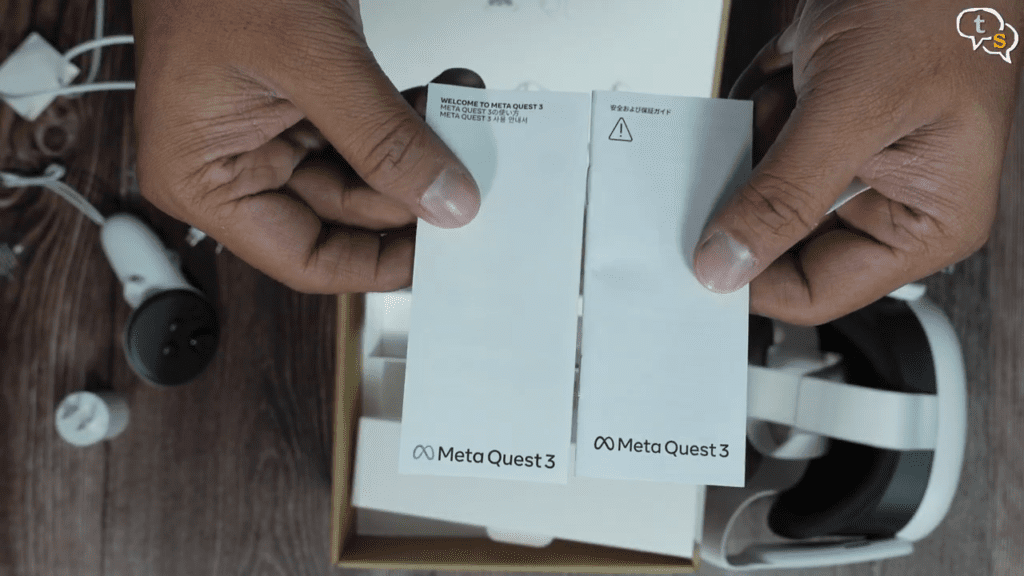

Manuals.
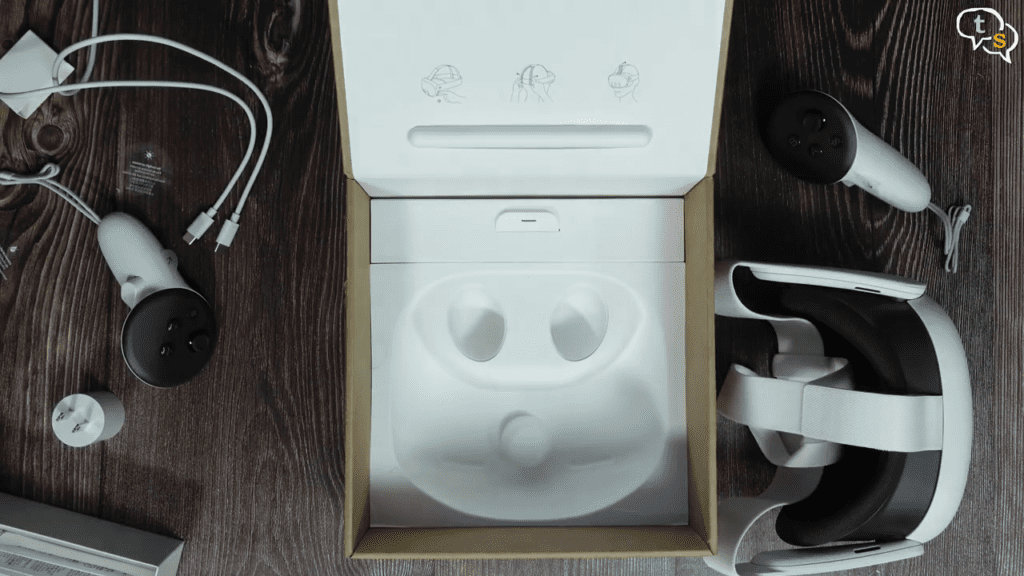

Nice box, I can use it to store the headset and controllers safely.
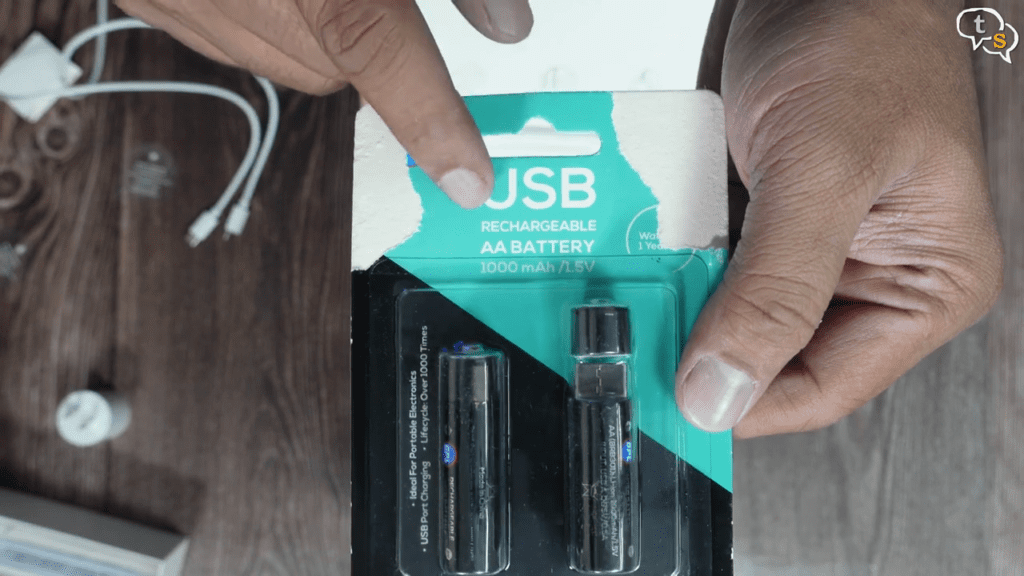

My kit also came with rechargeable usb – aa batteries. First-time I’m seeing something like this. The controllers need these batteries, but they come with batteries pre-installed so why these?
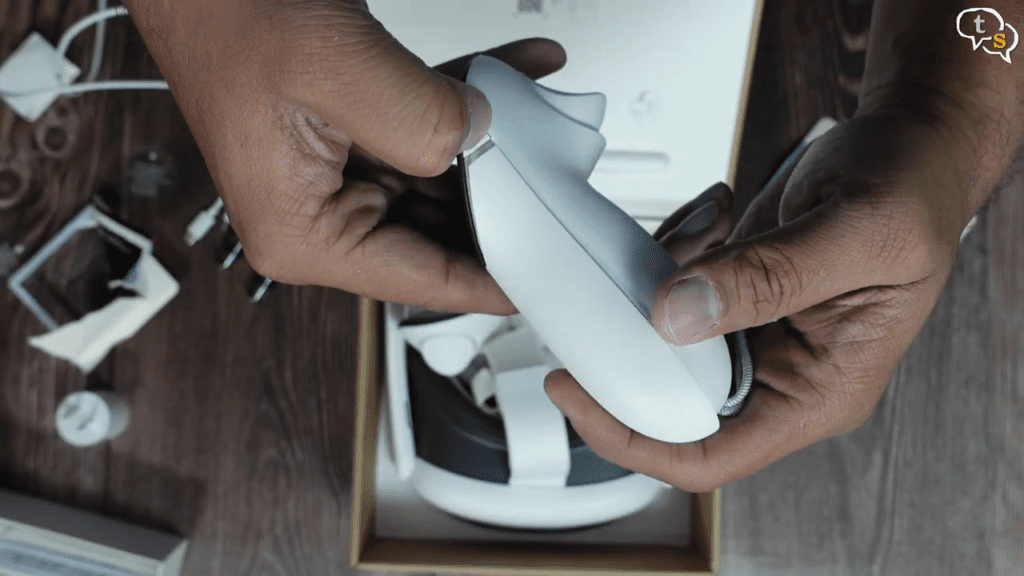

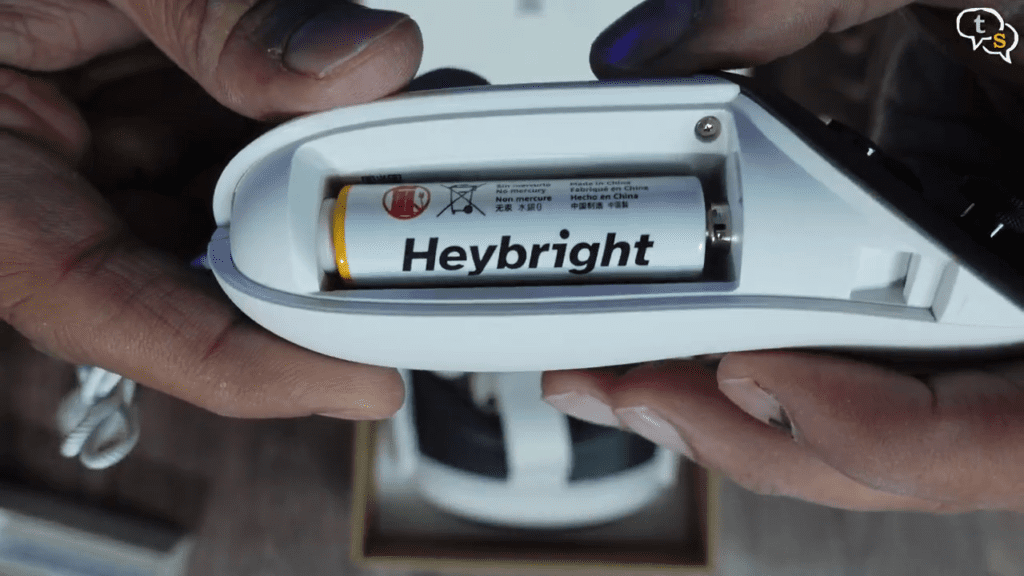

The controller has this button here, push it down and the cover opens up. We have a “heybright” battery, never heard of the brand.
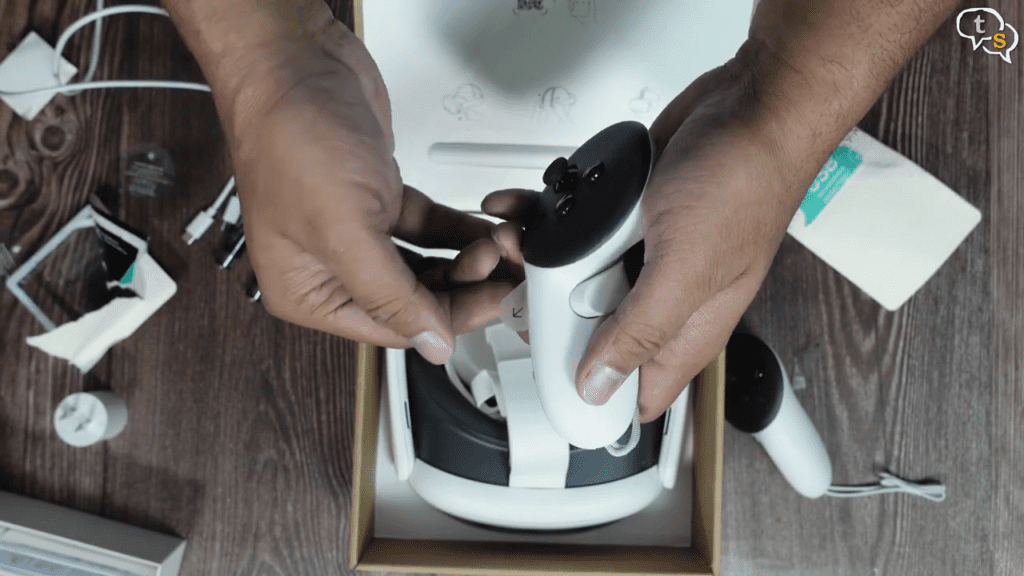

Pull off this plastic tag here, to activate the controller. Now we’re ready to set up the meta quest 3.
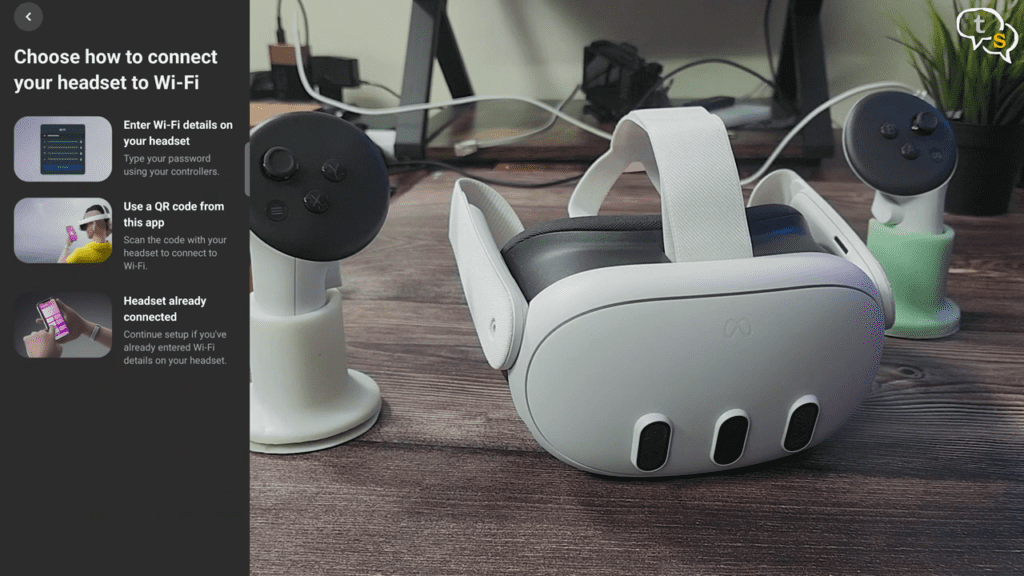

Using the Meta app on your phone, you will need a meta account for which if you already have a facebook, instagram account it can be used to login.
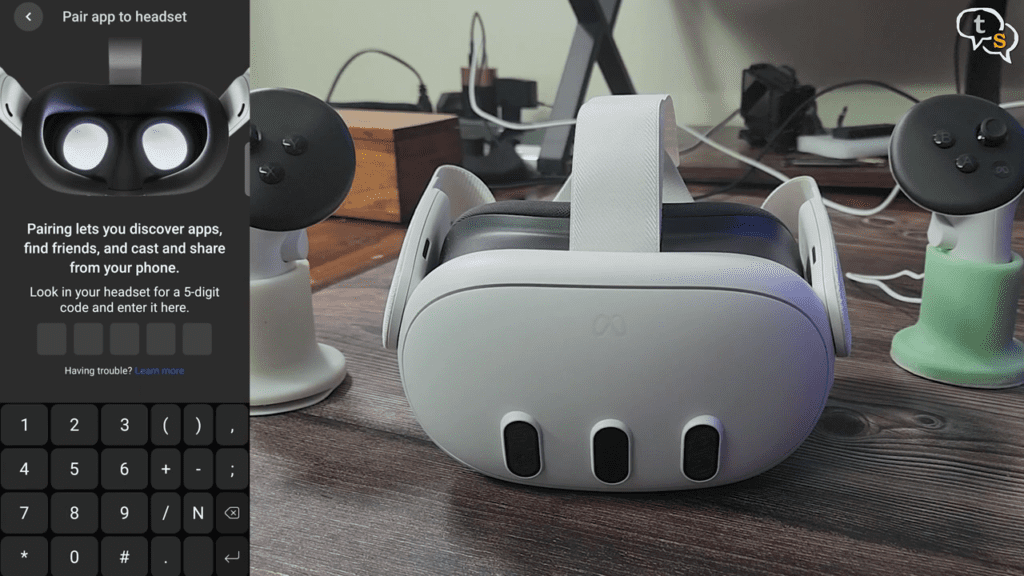

Once logged into the app, let’s pair the headset. Enter your Wi-Fi details, and make sure Bluetooth is on, on your phone, using the cameras on your phone you can create an avatar. Now to pair the headset, headset found, enter the number present on screen into the app and now we’re paired.
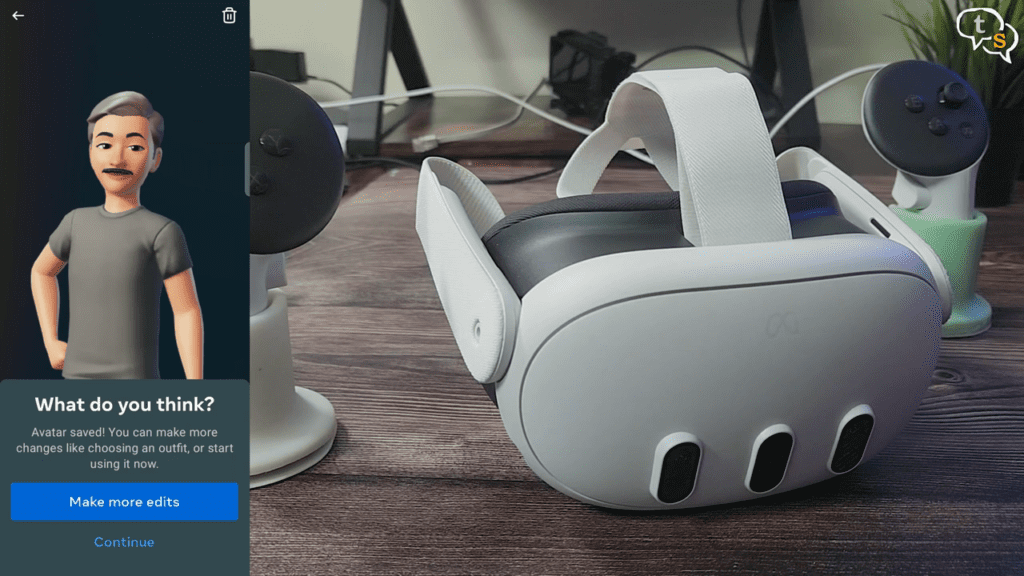

Cool, it did take a few tries, but it still went through quite seamlessly.
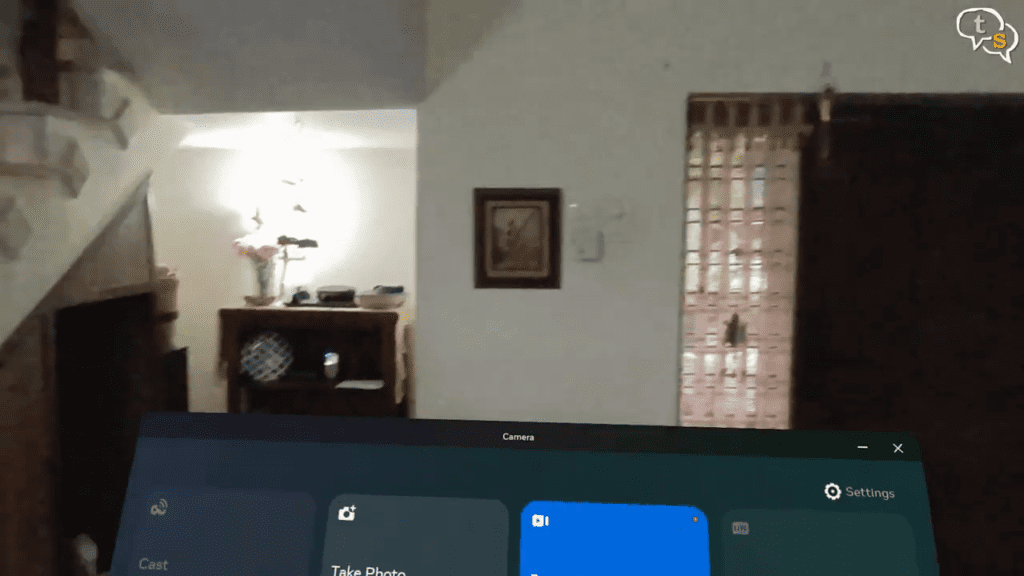

Wow, we have colour pass through which is a plus as compared to the Quest 2’s grayscale view which was also blurry.
The Quest 3’s is miles ahead, not that it’s perfect, but much better nonetheless.
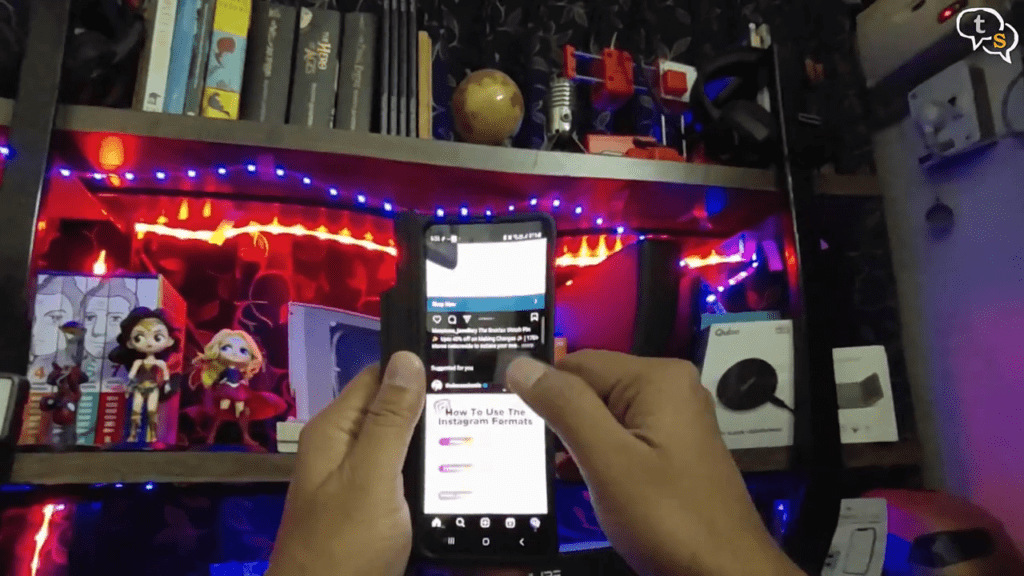

There is still distortion when trying to view objects in front of you, but you can still walk around quite comfortably as there’s no latency.
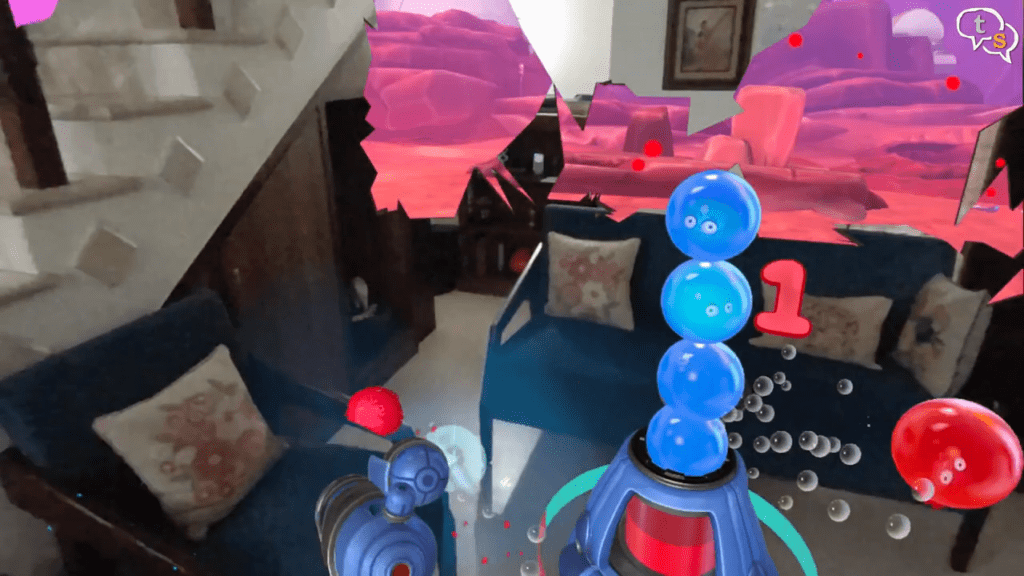

This is a plus for Mixed Reality where we have 3d objects mixed with your real space.
The boundary or safe play space is generated using the sensors and cameras on the headset, and it’s quite fast. No need for any external sensors, everything is within the headset.
The boundary is made quite fast and allows for small areas to play too.
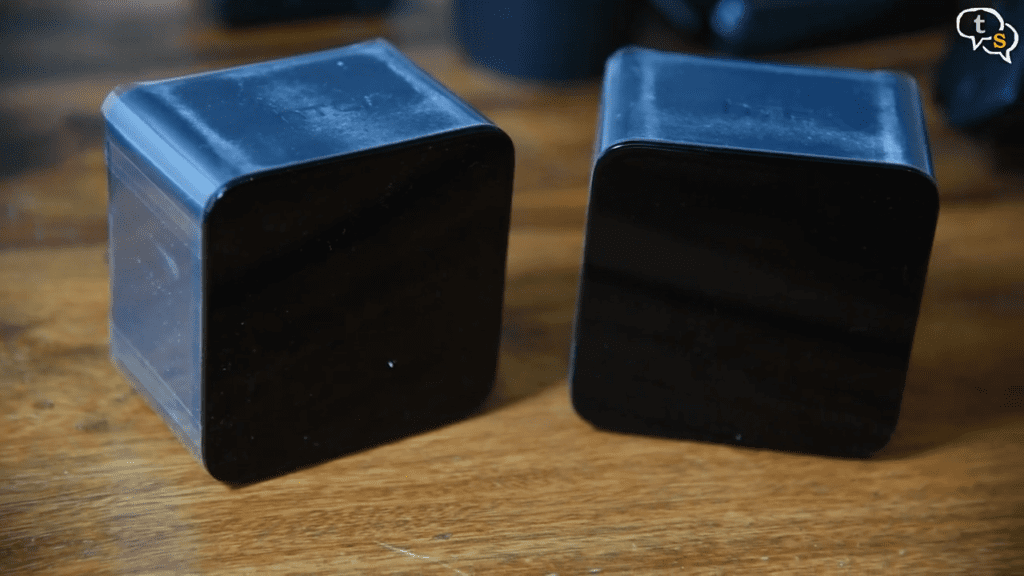

My Vive needed these light boxes and it needed to be in line of sight for better tracking. We needed at least two, so placing these and powering them was troublesome.
The Quest 3 having all the tracking within the headset and controllers makes it so much easier to just wear and start using.


I also found that it remembers the boundaries you have created around the house and it just picks up on them and notifies us if we want to use the already existing boundary or create a new one.
Once the boundary is created and we move towards the edge, it shows up as a grid which when we pass our hand through shows up in red. The grid is the safe area, crossing it may cause you to hit a wall or other objects which the cameras and sensor took into consideration when it created the boundary. If an object is added later, there is no guarantee it will find it, so make sure your play area is clear before starting or rescan the boundary.


The Qualcomm Snapdragon XR2 Gen 2 processor and 8GB of RAM in the Quest 3, makes it a beast as a standalone VR headset. It boot’s quite fast, and games load quite fast too.
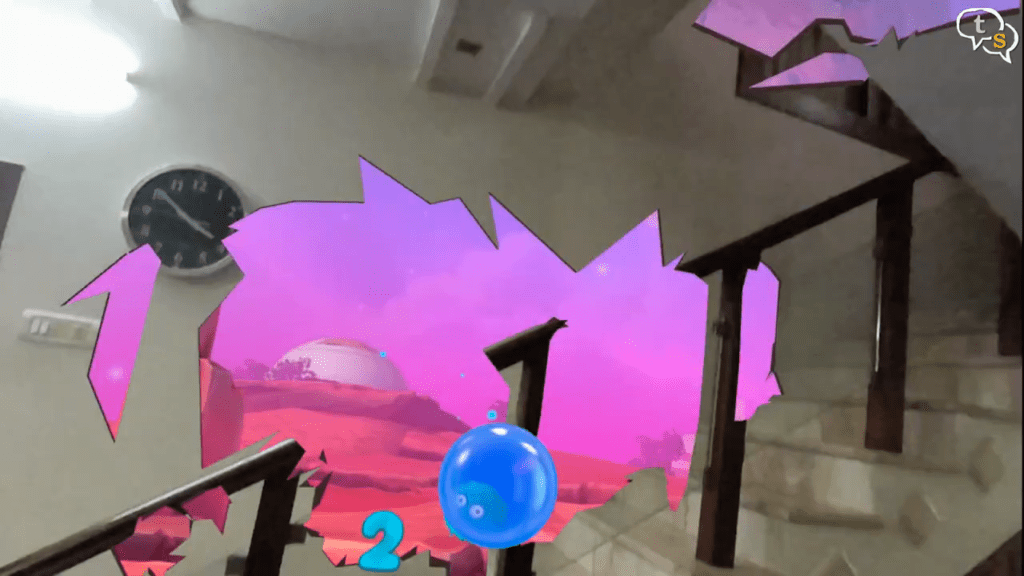

To try MR out we have a demo game named First Encounters. We scan around the room, in this case, the objects are also taken into consideration and become part of the game. We have these cute little aliens that keep popping up through holes in the wall and ceiling and we need to collect them. They can hide under your sofas and other objects which makes the game even more immersive. The 120 Hz refresh rate, does make the experience more enjoyable and less straining on the eyes.
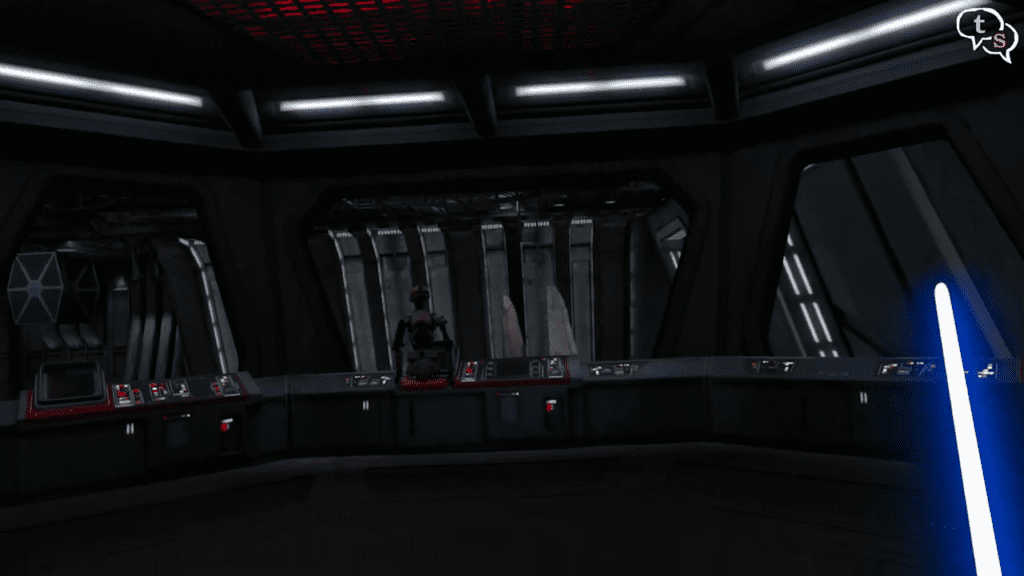

Traditional VR titles work too, and I love this Star Wars game where we act like a Jedi and we can force pull/ push and cut enemies down using your lightsaber.
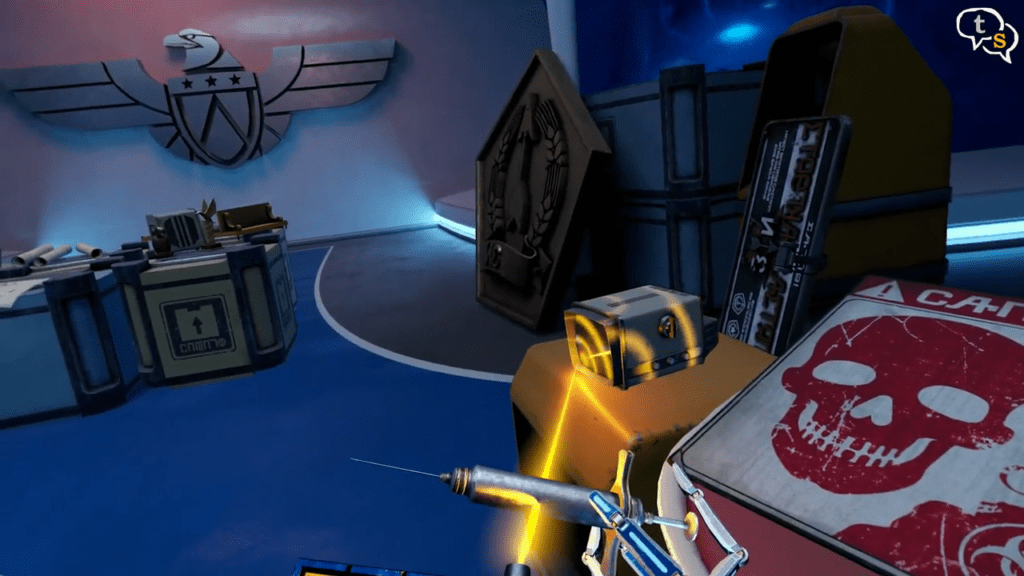

The play time is short but is still fun. Red Matter 2 is another game that’s advertised as a game changer, with updated textures for the quest 3 does make it look great.
We have games like roller coasters, and some horror games too.
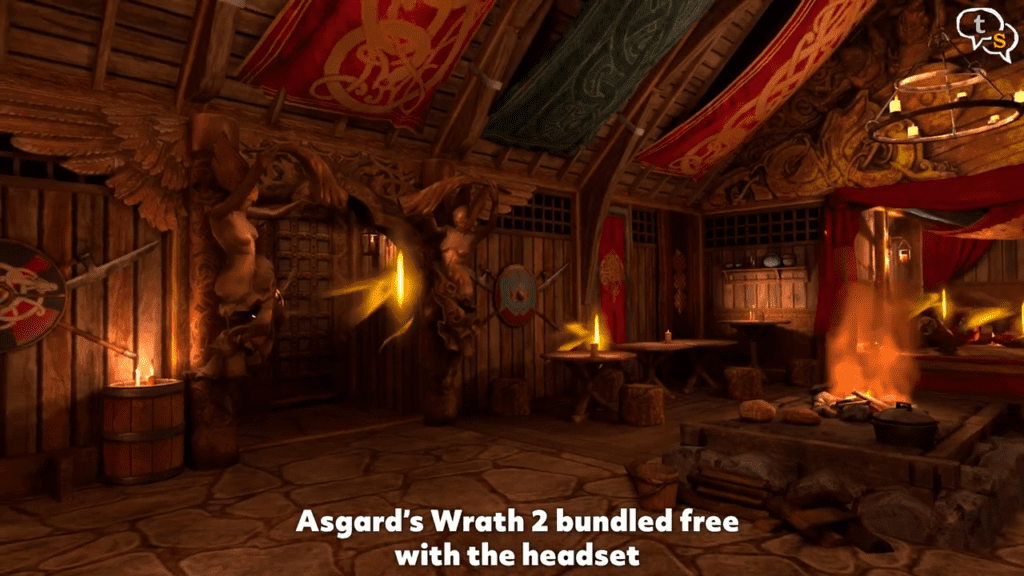

The headset came bundled with Asgards Wrath 2 which is supposed to be a massive RPG, with sidequests and a lot of combat. It’s supposed to be a showcase game for the Quest 3, I’ve installed it but I didn’t get to play it much as it just released at the time of writing this review.
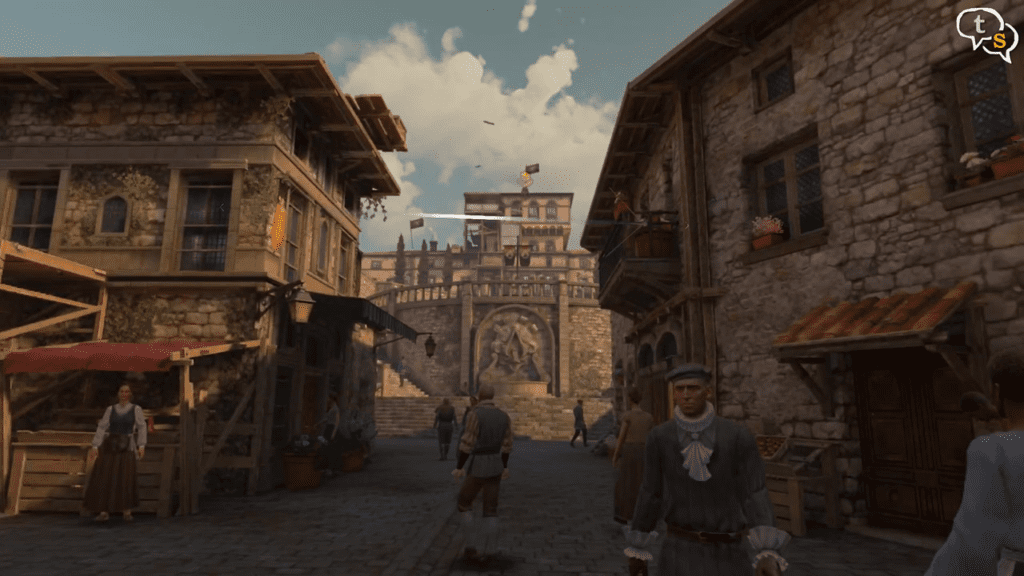

We have other games like Assassin’s Creed Nexus, which was the first game I tried and the movement did make me nauseous which was surprising as i already have experience with VR. If you move while still standing in place, the brain gets confused and makes you sick. After a while, you do get used to it.
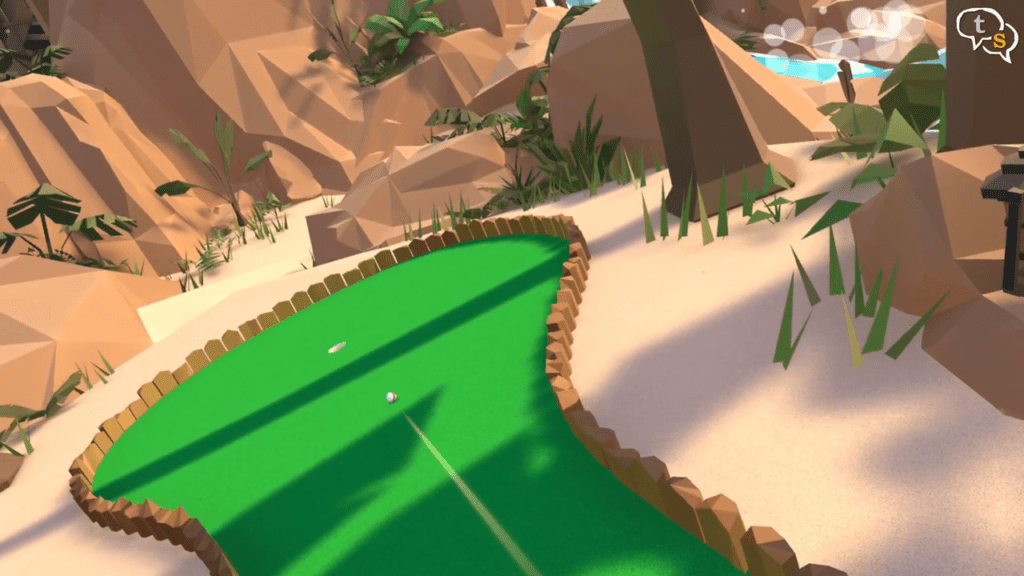

I then tried out a few rounds of mini golf and it’s really fun. We have multiple locations to play in and you need to move the putter as you would in real life. I really enjoyed this title.
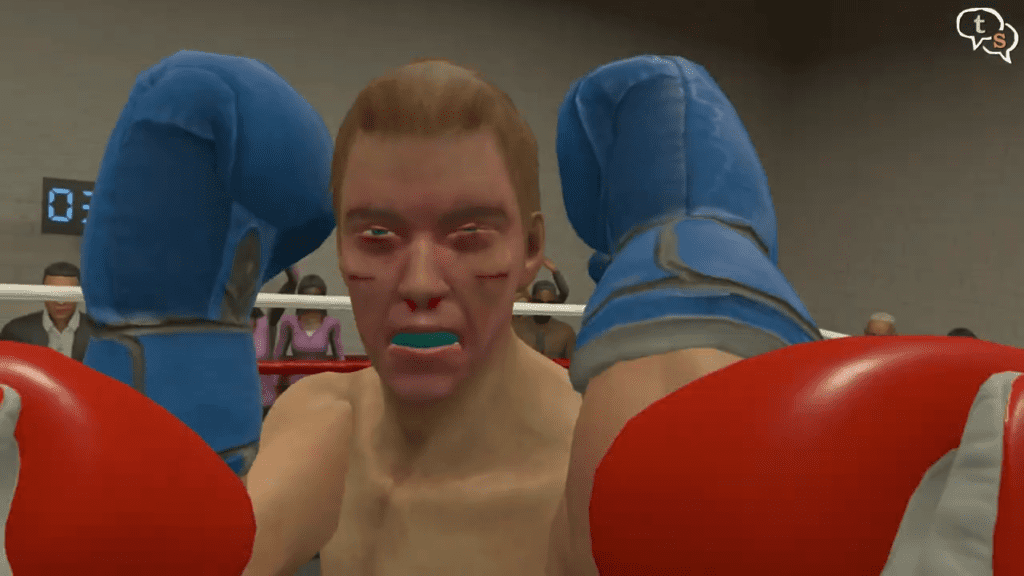

Thrill of the fight, allows you to box in VR, but make sure you clear out the area before playing as you could hurt yourself by hitting a wall or someone who’s walking by. Sports games in VR make you feel like you’re actually playing at the location.
There are tons of games from casual to AAA level VR gaming.
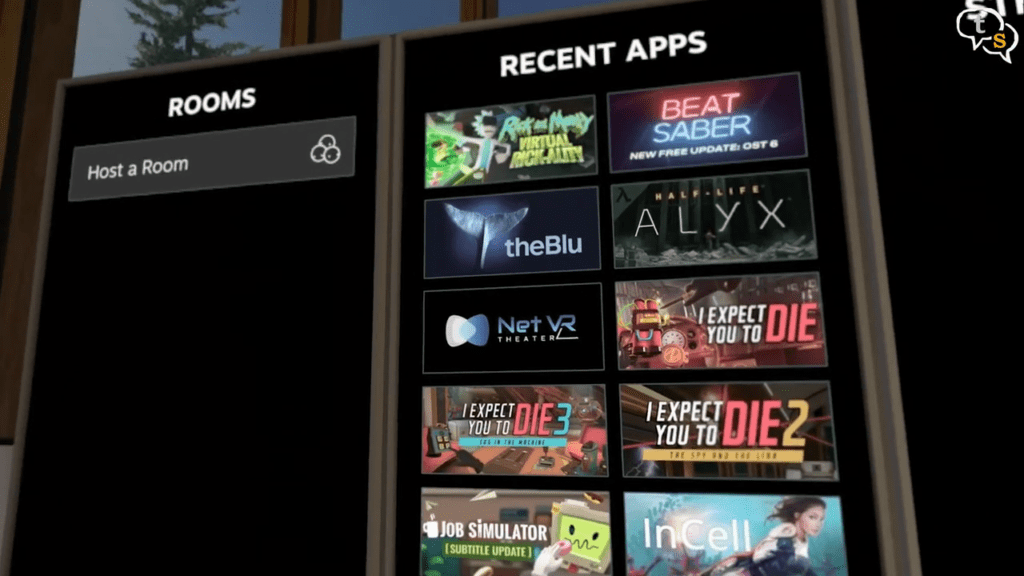

Games on the Quest store are expensive and I have a lot of them on my PC and didn’t want to purchase them again. To play these PC games on the quest 3 we have an app named steamlink, connect to the computer you have steam active on and we have access to the whole library of PC VR games. This allows us to use the PC’s powerful hardware and storage to play these games and as the processing is on the PC the battery drains slower on the headset. Storage is also on PC and not the headset so the paltry storage provided does not cause any problems. Everything is not hunky dory though, as there are times when the video quality does fall as it is streamed off the PC onto the headset, but if you have good mesh wifi at home it works wonderfully. Make sure the PC is connected via ethernet to your router and the headset is connected to 5 GHz wifi. Did I mention all this was wireless, no cable is required to connect between the PC and the Quest 3 headset.
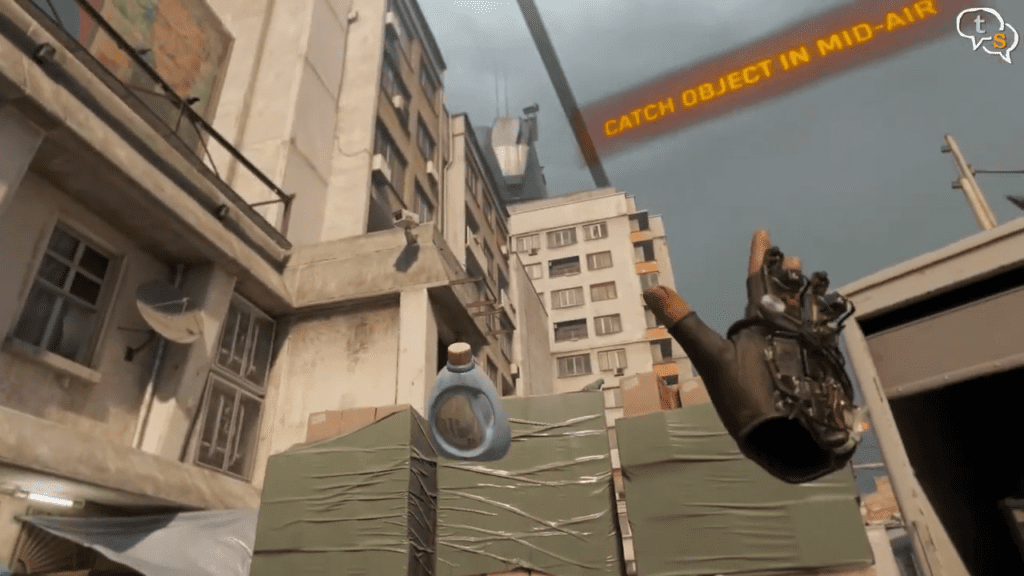

So you can play anywhere as long as you are on the same wifi. Half life Alyx a serious VR game which is the showcase for PC VR gaming, works really well and the interactivity works how it’s supposed to without any problems.
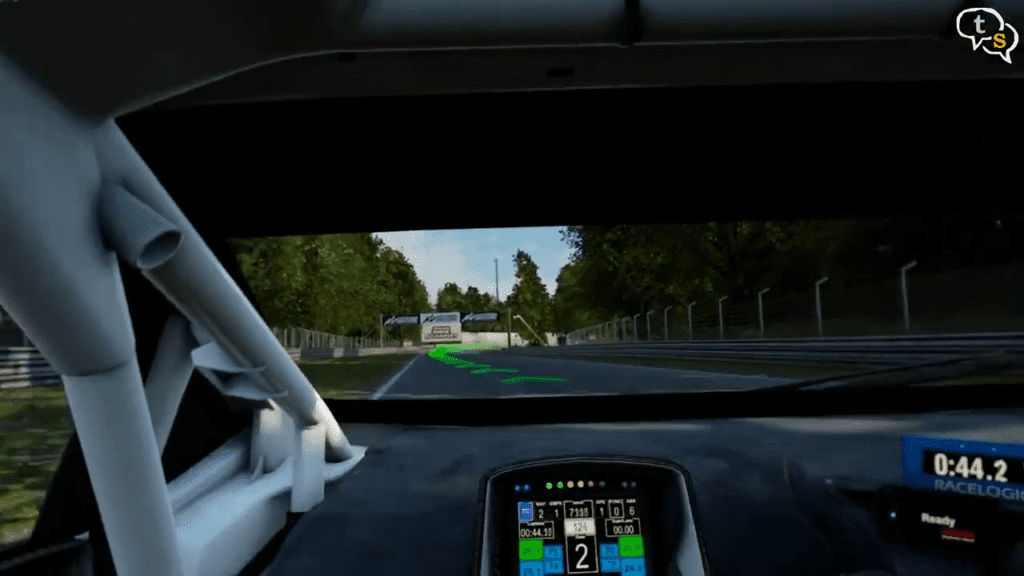

Asetto corsa, a car racing game allows you to drive in VR allowing you to look in all directions while driving.
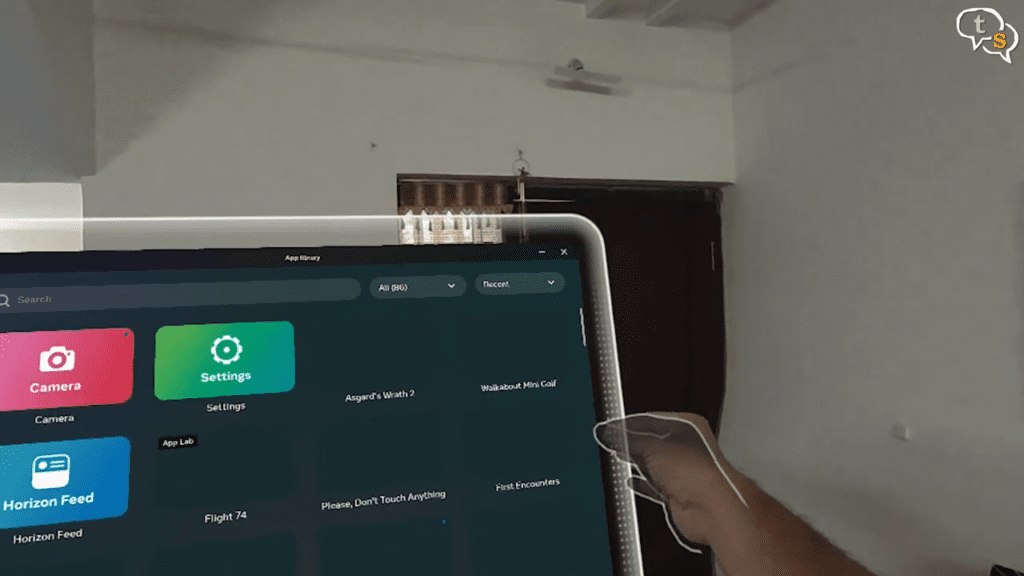

Hand tracking is another fantastic feature, we can keep the controls away and use only our hands to control on screen items. Select apps, resize or move windows, really cool. We can do most interactions using only our hands.
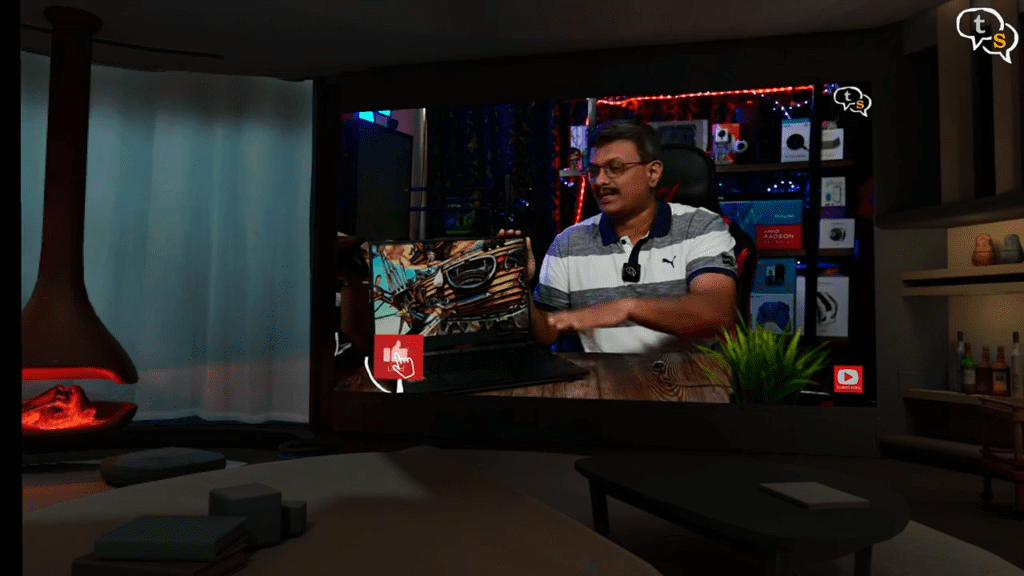

We can view streaming video via YouTube VR or Netflix, the headset simulates a theatre-like experience with a huge screen before you.
If you are within a game and you need to peek out for a bit, just double tap the side of your headset and passthrough activates.
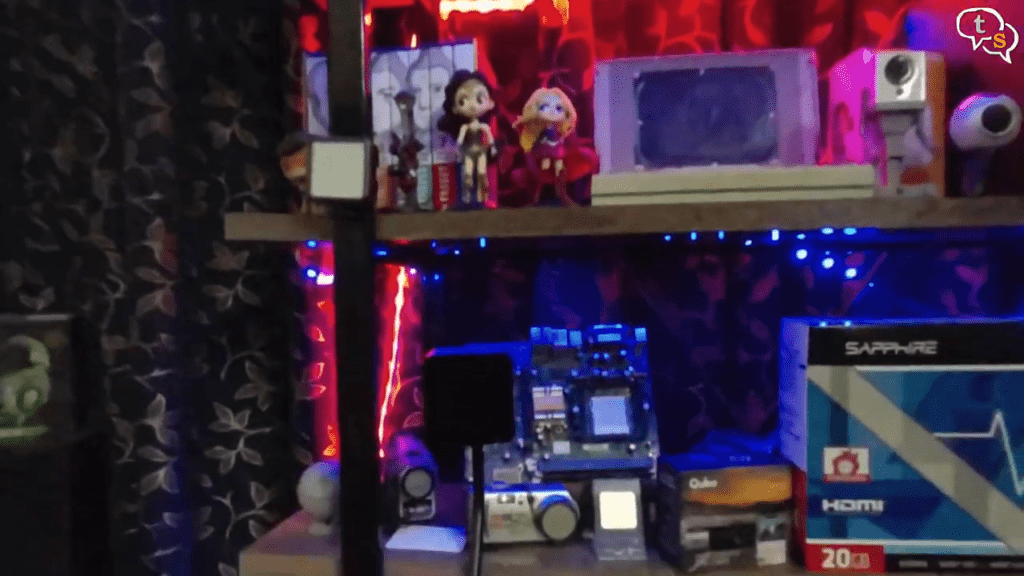

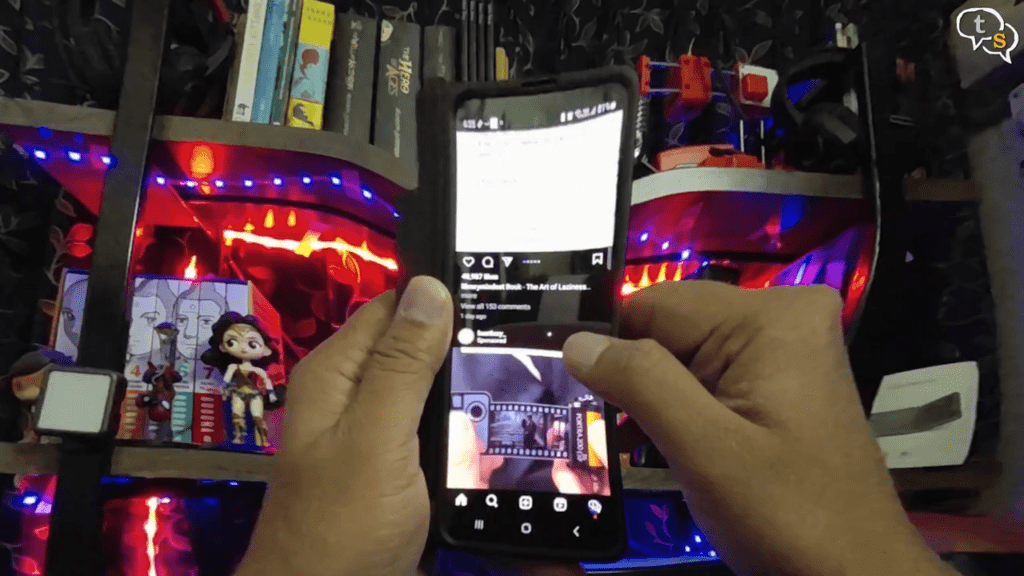

The passthrough works well, in low light it is a bit grainy, but still enough to make you be able to navigate around your house.
There’s a bit of warping around the edges, so it can seem a little bit like the floor is moving, it also warps and distorts around your hands, so if you want to use your phone , it’s trippy. You can pick up calls easily, but typing a text is not easy.
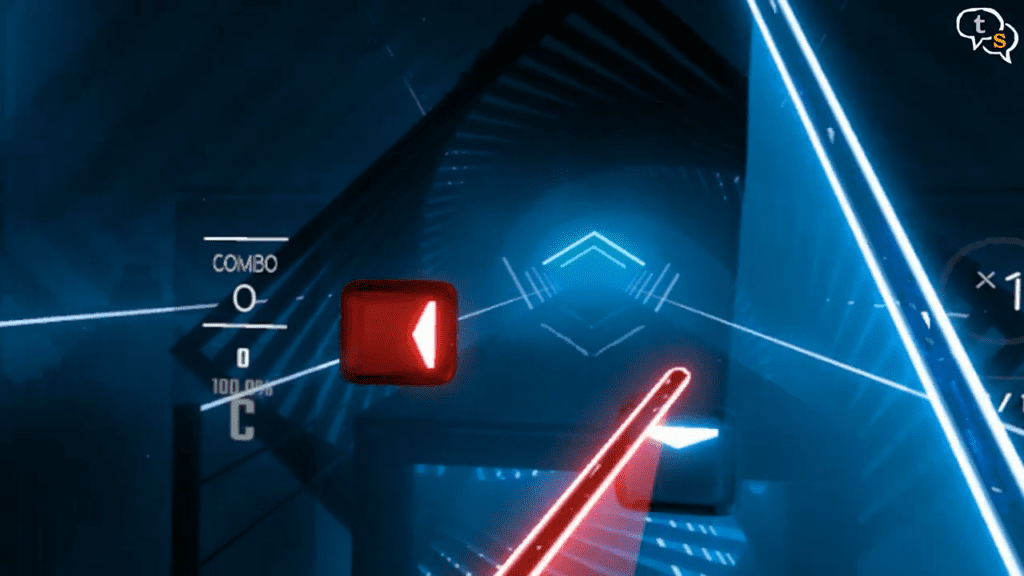

The speakers are fine, it gets loud, Sound quality is great, but at max volume, it was not unpleasant, you do miss some frequency ranges, so if you are playing music-based games like Beat Saber or want more immersion I would suggest using headphones or even Bluetooth earbuds.
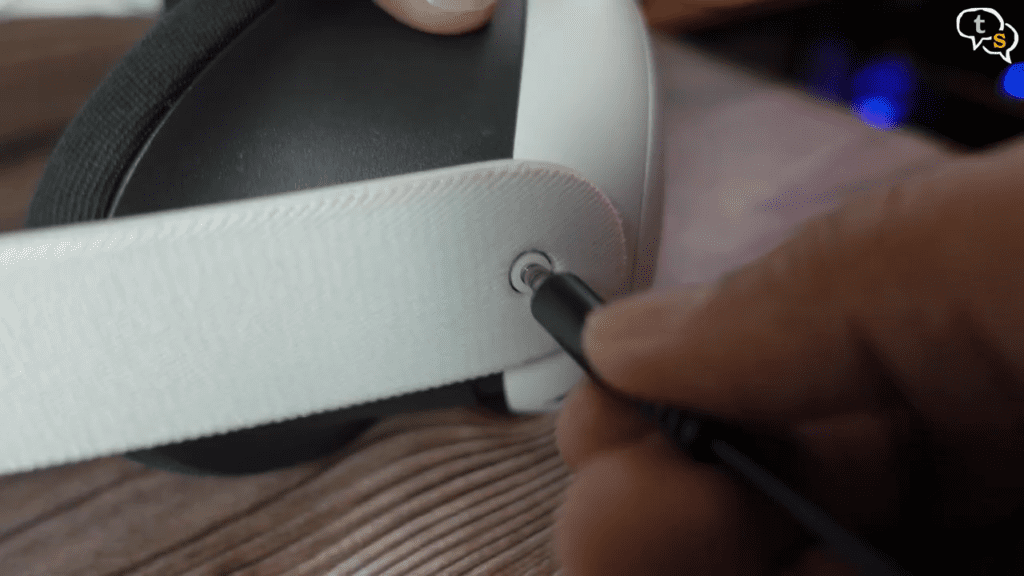

This 3.5 mm jack here allows for easily attaching one to the Quest 3, and with Bluetooth we have the choice to pair wireless earbuds.


Battery life depends on the title you’re playing, we get around 2 hours, which I’m not complaining about, as 2 hours in VR is quite long. If you are playing with others in a line, the battery will not be adequate as if there are multiple players 2 hours might not be enough. The batteries on the controllers last really long, so you will not need to change them for a few months.
There are tons of players trying to make their name in VR, but the Quest 3 has taken it a step forward by including MR or mixed reality. it is, hands down, the best way at present to engage in VR games , ahem experiences. The wireless feature is also a big plus, which in future when Apple’s vision pro does release the Quest 3 would already be a big contender against it. The standard strap included does get caught in my hair and also does push down on my ear. I’ve ordered a different strap, which has an includes battery, but it has not been delivered as yet, so couldn’t show how well it works.
Considering the pricing the Quest 3 has already won, but feature-wise, eye tracking and a whole host of sensors that are also present on the Quest Pro, there’s a lot amiss, for most people this is a more affordable and quite value for money. It does everything well, and at that price, it’s still affordable. It is a significant step up over the Quest 2 and is much easier to set up and use as compared to my htc vive, considering I don’t need an external device to run the headset. There are tons of games available one the quest store ranging from casual puzzlers to ultra-intense shooters and practically everything in between. And, of course, through Steam Link, you can plug your headset into your computer and play a library of PC VR games as well.
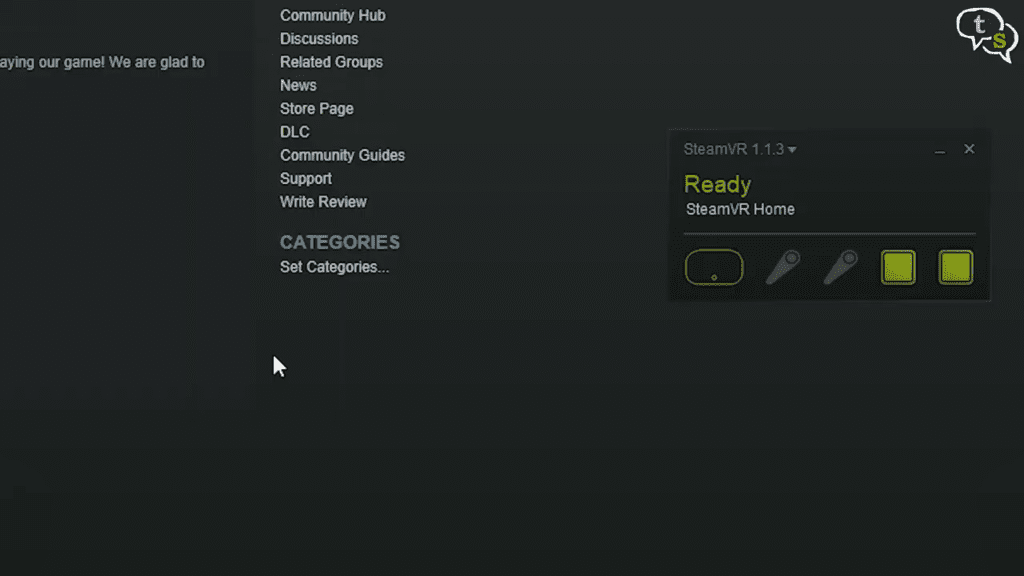

Now I don’t need to check if my PC is detecting my headset and controls, is everything powered .
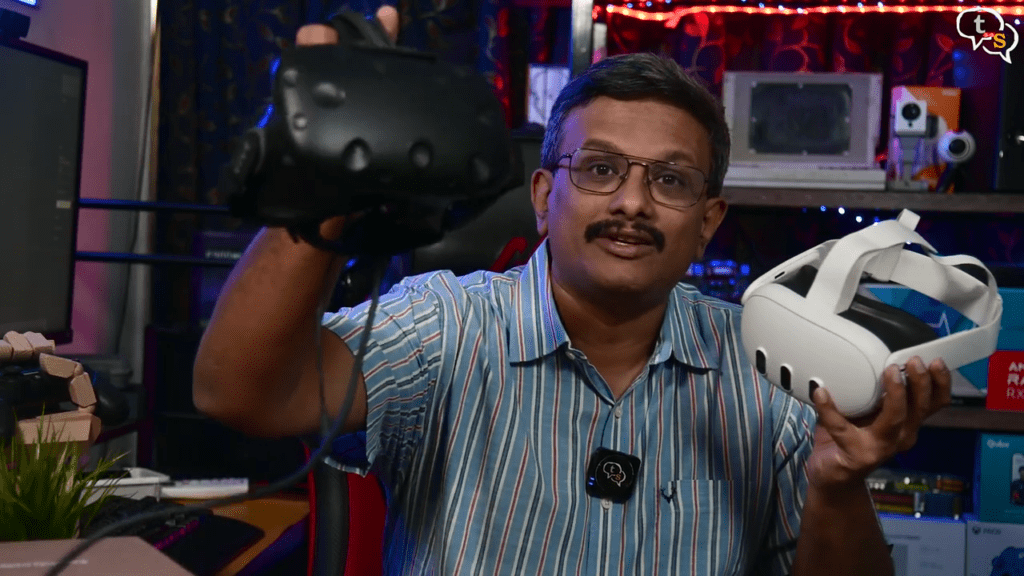

It used to take me 30 minutes of troubleshooting before I could even play on my HTC Vive. Now with the quest 3, it allows me to just pick up and start playing VR games without the inconvenience of traditional VR.
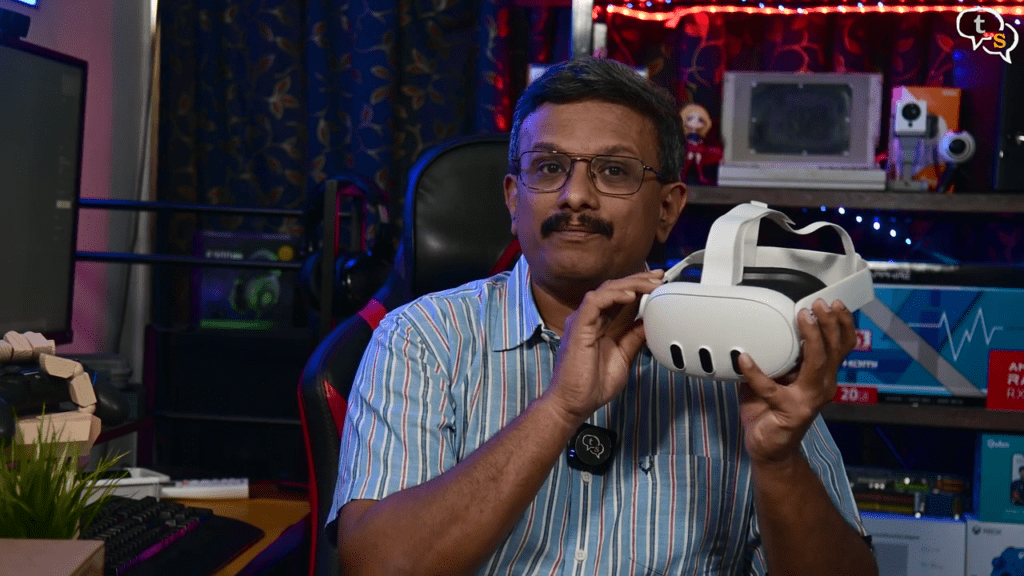

The Quest 3 is the PC, so it’s self-contained and the cameras track the controllers. It has made me fall in love with VR again and also has given us a taste of Mixed reality.
So what do you guys think, is it worth it, or is there any better offering out there, make sure to comment below.


Vinayak Nair is a self-confessed geek from the days when computer memory was measured in Kilobytes. I create YouTube videos on 3D Printing, DIY Projects, Everyday tech reviews and also delve into gaming.






